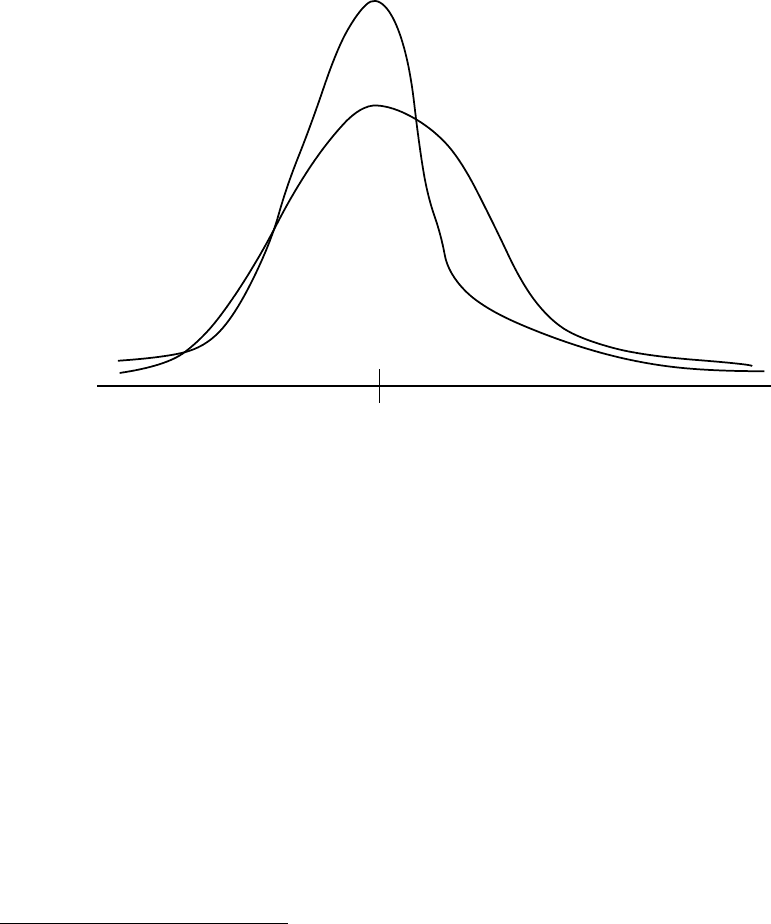Damodaran A. Applied corporate finance
Подождите немного. Документ загружается.


54
Live Case Study
I. Corporate Governance Analysis
Objective: To analyze the corporate governance structure of the firm and to assess where
the power in the firm lies – with incumbent management or with stockholders in the
firm?
Key Questions:
• Is this a company where there is a separation between management and ownership? If
so, how responsive is management to stockholders?
• Is there a potential conflict between stockholders and lenders to the firm? If so, how
is it managed?
• How does this firm interact with financial markets? How do markets get information
about the firm?
• How does this firm view its social obligations and manage its image in society?
Framework for Analysis:
1. The Chief Executive Officer
• Who is the CEO of the company? How long has he or she been CEO?
• If it is a “family run” company, is the CEO part of the family? If not, what
career path did the CEO take to get to the top? (Did he or she come from
within the organization or from outside?)
• How much did the CEO make last year? What form did the compensation
take? (Salary, bonus and option components)
• How much stock and options in the company does the CEO own?
2. The Board of Directors
• Who is on the board of directors of the company? How long have they served
as directors?
• How many of the directors are “inside” directors?
• How many of the directors have other connections to the firm (as suppliers,
clients, customers..)?
• How many of the directors are CEOs of other companies?
• Do any of the directors have large stockholdings or represent those who do?
55
3. Bondholder Concerns
• Does the firm have any publicly traded debt?
• Are there are bond covenants (that you can uncover) that have been imposed
on the firm as part of the borrowing?
• Do any of the bonds issued by the firm come with special protections against
stockholder expropriation?
4. Financial Market Concerns
• How many analysts follow the firm?
• How much trading volume is there on this stock?
5. Societal Constraints
• What does the firm say about its social responsibilities?
• Does the firm have a particularly good or bad reputation as a corporate
citizen?
• If it does, how has it earned this reputation?
• If the firm has been a recent target of social criticism, how has it responded?
Information Sources:
For firms that are incorporated in the United States, information on the CEO and
the board of directors is primarily in the filings made by the firm with the Securities and
Exchange Commission. In particular, the 14-DEF will list out the directors in the firm,
their relationship with the firm and details on compensation for both directors and top
managers. You can also get information on trading done by insiders from the SEC filings.
For firms that are not listed in the United States, this information is much more difficult
to obtain. However, the absence of readily accessible information on directors and top
management is more revealing about the power that resides with incumbent managers.
Information on a firm’s relationships with bondholders usually resides in the
firm’s bond agreements and loan covenants. While this information may not always be
available to the public, the presence of constraints shows up indirectly in the firm’s bond
ratings and when the firm issues new bonds.
The relationship between firms and financial markets is an uneasy one. The list of
analysts following a firm can be obtained from publications such as the Nelson Directory

56
of Securities Research. For larger and more heavily followed firms the archives of
financial publications (the Financial Times, Wall Street Journal, Forbes, Barron’s) can be
useful sources of information.
Finally, the reputation of a firm as a corporate citizen is the toughest area to
obtain clear information on, since it is only the outliers (the worst and the best corporate
citizens) that make the news. The proliferation of socially responsible mutual funds,
however, does give us a window on those firms that pass the tests (arbitrary, though they
sometimes are) imposed by these funds for a firm to be viewed as “socially responsible”.
Online sources of information:
http://www.stern.nyu.edu/~adamodar/cfin2E/project/data.htm

1
CHAPTER 3
THE BASICS OF RISK
Risk, in traditional terms, is viewed as a negative and something to be avoided.
Webster’s dictionary, for instance, defines risk as “exposing to danger or hazard”. The
Chinese symbols for risk, reproduced below, give a much better description of risk –
The first symbol is the symbol for “danger”, while the second is the symbol for
“opportunity”, making risk a mix of danger and opportunity. It illustrates very clearly the
tradeoff that every investor and business has to make – between the “higher rewards” that
potentially come with the opportunity and the “higher risk” that has to be borne as a
consequence of the danger. The key test in finance is to ensure that when an investor is
exposed to risk that he or she is “appropriately” rewarded for taking this risk.
In this chapter, we will lay the foundations for analyzing risk in corporate finance
and present alternative models for measuring risk and converting these risk measures into
“acceptable” hurdle rates.
Motivation and Perspective in Analyzing Risk
Why do we need a model that measures risk and estimates expected return? A
good model for risk and return provides us with the tools to measure the risk in any
investment and uses that risk measure to come up with the appropriate expected return on
that investment; this expected return provides us with the hurdle rate in project analysis.
What makes the measurement of risk and expected return so challenging is that it
can vary depending upon whose perspective we adopt. When analyzing Disney’s risk, for
instance, we can measure it from the viewpoint of Disney’s managers. Alternatively, we
can argue that Disney’s equity is owned by its stockholders, and that it is their
perspective on risk that should matter. Disney’s stockholders, many of whom hold the
stock as one investment in a larger portfolio, might perceive the risk in Disney very
differently from Disney’s managers, who might have the bulk of their capital, human and
2
financial, invested in the firm. In this chapter, we will argue that risk in an equity
investment has to be perceived through the eyes of investors in the firm. Since firms like
Disney often have thousands of investors, often with very different perspectives, we will
go further. We will assert that risk has to be measured from the perspective of not just
any investor in the stock, but of the marginal investor, defined to be the investor most
likely to be trading on the stock at any given point in time. The objective in corporate
finance is the maximization of firm value and stock price. If we want to stay true to this
objective, we have to consider the viewpoint of those who set the stock prices, and they
are the marginal investors.
Finally, the risk in a company can be viewed very differently by investors in its
stock (equity investors) and by lenders to the firm (bondholders and bankers). Equity
investors who benefit from upside as well as downside tend to take a much more
sanguine view of risk than lenders who have limited upside but potentially high
downside. We will consider how to measure equity risk in the first part of the chapter and
risk from the perspective of lenders in the latter half of the chapter.
We will be presenting a number of different risk and return models in this chapter.
In order to evaluate the relative strengths of these models, it is worth reviewing the
characteristics of a good risk and return model.
1. It should come up with a measure of risk that applies to all assets and not be
asset-specific.
2. It should clearly delineate what types of risk are rewarded and what are not,
and provide a rationale for the delineation.
3. It should come up with standardized risk measures, i.e., an investor presented
with a risk measure for an individual asset should be able to draw conclusions
about whether the asset is above-average or below-average risk.
4. It should translate the measure of risk into a rate of return that the investor
should demand as compensation for bearing the risk.
5. It should work well not only at explaining past returns, but also in predicting
future expected returns.

3
Equity Risk and Expected Returns
To understand how risk is viewed in corporate finance, we will present the
analysis in three steps. First, we will define risk in terms of the distribution of actual
returns around an expected return. Second, we will differentiate between risk that is
specific to an investment or a few investments and risk that affects a much wider cross
section of investments. We will argue that when the marginal investor is well diversified,
it is only the latter risk, called market risk that will be rewarded. Third, we will look at
alternative models for measuring this market risk and the expected returns that go with
this risk.
I. Measuring Risk
Investors who buy an asset expect to make a return over the time horizon that they
will hold the asset. The actual return that they make over this holding period may by very
different from the expected return, and this is where the
risk comes in. Consider an investor with a 1-year time
horizon buying a 1-year Treasury bill (or any other
default-free one-year bond) with a 5% expected return.
At the end of the 1-year holding period, the actual
return that this investor would have on this investment will always be 5%, which is equal
to the expected return. The return distribution for this investment is shown in Figure 3.1.
Variance in Returns: This is a
measure of the squared difference
between the actual returns and the
expected returns on an investment.

4
This is a riskless investment, at least in nominal terms.
To provide a contrast, consider an investor who invests in Disney. This investor,
having done her research, may conclude that she can make an expected return of 30% on
Disney over her 1-year holding period. The actual return over this period will almost
certainly not be equal to 30%; it might be much greater or much lower. The distribution
of returns on this investment is illustrated in Figure 3.2:

5
In addition to the expected return, an investor now has to consider the following. First,
the spread of the actual returns around the expected return is captured by the variance or
standard deviation of the distribution; the greater the deviation of the actual returns from
expected returns, the greater the variance. Second, the bias towards positive or negative
returns is captured by the skewness of the distribution. The distribution above is
positively skewed, since there is a greater likelihood of large positive returns than large
negative returns. Third, the shape of the tails of the distribution is measured by the
kurtosis of the distribution; fatter tails lead to higher kurtosis. In investment terms, this
captures the tendency of the price of this investment to “jump” in either direction.
In the special case of the normal distribution, returns are symmetric and investors
do not have to worry about skewness and kurtosis, since there is no skewness and a
normal distribution is defined to have a kurtosis of zero. In that case, it can be argued that
investments can be measured on only two dimensions - (1) the 'expected return' on the
investment comprises the reward, and (2) the variance in anticipated returns comprises
the risk on the investment. Figure 3.3 illustrates the return distributions on two
investments with symmetric returns-

6
Figure 3.3: Return Distribution Comparisons
Expected Return
Low Variance Investment
High Variance Investment
In this scenario, an investor faced with a choice between two investments with the same
standard deviation but different expected returns, will always pick the one with the higher
expected return.
In the more general case, where distributions are neither symmetric nor normal, it
is still conceivable, though unlikely, that investors still choose between investments on
the basis of only the expected return and the variance, if they possess utility functions
1
that allow them to do so. It is far more likely, however, that they prefer positive skewed
distributions to negatively skewed ones, and distributions with a lower likelihood of
jumps (lower kurtosis) over those with a higher likelihood of jumps (higher kurtosis). In
this world, investors will trade off the good (higher expected returns and more positive
skewness) against the bad (higher variance and kurtosis) in making investments. Among
1
A utility function is a way of summarizing investor preferences into a generic term called ‘utility’ on the
basis of some choice variables. In this case, for instance, investor utility or satisfaction is stated as a
function of wealth. By doing so, we effectively can answer questions such as – Will an investor be twice as
happy if he has twice as much wealth? Does each marginal increase in wealth lead to less additional utility
than the prior marginal increase? In one specific form of this function, the quadratic utility function, the
entire utility of an investor can be compressed into the expected wealth measure and the standard deviation
in that wealth, which provides a justification for the use of a framework where only the expected return
(mean) and its standard deviation (variance) matter.

7
the risk and return models that we will be examining, one (the capital asset pricing model
or the CAPM) explicitly requires that choices be made only in terms of expected returns
and variances. While it does ignore the skewness and kurtosis, it is not clear how much of
a factor these additional moments of the distribution are in determining expected returns.
In closing, we should note that the return moments that we run into in practice are
almost always estimated using past returns rather than future returns. The assumption we
are making when we use historical variances is that past return distributions are good
indicators of future return distributions. When this assumption is violated, as is the case
when the asset’s characteristics have changed significantly over time, the historical
estimates may not be good measures of risk.
☞: 3.1: Do you live in a mean-variance world?
Assume that you had to pick between two investments. They have the same
expected return of 15% and the same standard deviation of 25%; however, investment A
offers a very small possibility that you could quadruple your money, while investment
B’s highest possible payoff is a 60% return. Would you
a. be indifferent between the two investments, since they have the same expected return
and standard deviation?
b. prefer investment A, because of the possibility of a high payoff?
c. prefer investment B, because it is safer?
Illustration 3.1: Calculation of standard deviation using historical returns: Disney
We collected the data on the returns we would have made on a monthly basis for
every month from January 1999 to December 2003 on an investment in Disney stock.
The monthly returns are graphed in figure 3.4:
